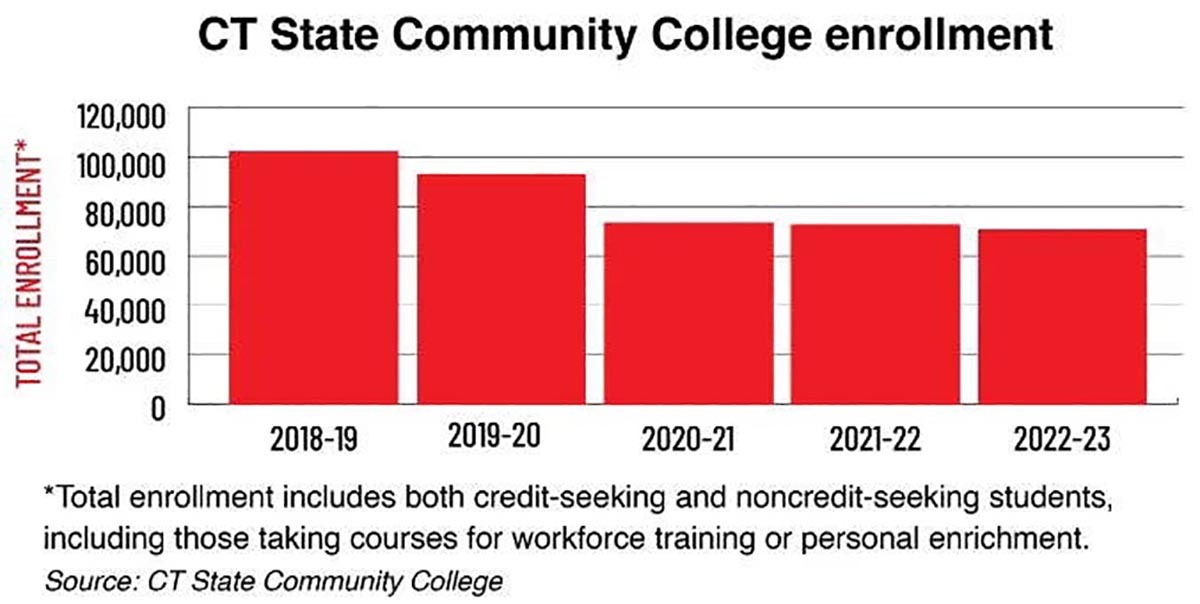Maduko, president of fledgling CT community college system, eyes fiscal stability, enrollment boost

John Maduko acknowledges the entire Connecticut State Community College system, from students to faculty and staff, have been through “a lot” in recent months.
As of July 1, 2023, a dozen community colleges across the state merged into one entity, CT State.
Maduko, a medical doctor, assumed the role of president of CT State in June 2022, in the midst of the major merger and reorganization, which has meant tough choices such as cutting costs and eliminating positions.
Looking forward, Maduko said his “number one” goal is to stabilize the institution as it forges ahead as one entity.
“(The merger) was a huge undertaking, if not historic, within the higher education landscape,” Maduko said. “Our mantra now is: Stabilize, build and thrive.”
He aims to expand brand awareness for CT State in the months ahead, as people are likely more familiar with its individual campuses — such as Gateway in New Haven, Capital in Hartford, and Tunxis in Farmington — which have had decades to build name recognition.
The New England Commission of Higher Education granted accreditation to CT State, which offers two-year degree programs, this past summer.
Students who attend have more than 300 degree and certificate credit programs to choose from and flexibility to take courses at more than one campus.
Financial headwinds
Balancing CT State’s budget is a top priority in the months ahead, Maduko said.
CT State recently had been facing an approximately $125 million deficit over the next couple of years, including $33.6 million for fiscal year 2024, and $91.3 million for fiscal year 2025.
As of mid-December, CT State was able to eliminate the fiscal year 2024 deficit, and reduced its fiscal year 2025 deficit by $50 million, Maduko said.
That was done through several money-saving measures, including reducing employees and eliminating some administrator and executive positions. There is an emphasis on prioritizing certain positions, such as public safety workers, mental health counselors, and faculty who are tied to an accredited program.
Some savings were achieved by eliminating or not filling vacant positions.
There have also been reductions in hours of operation and courses. CT State has examined vendor contracts for potential savings and found ways to be more efficient in utility usage, Maduko said.
“We’re going to have to continue these measures into the new year as a part of addressing our remaining $41.3 million deficit for fiscal year 2025,” Maduko said.
The cuts haven’t been without criticism. Students, faculty and staff have raised concerns about increased faculty workload, fewer courses being offered and reduced access to library and tutoring services.
Attracting students
Another key strategy for Maduko in the year ahead is boosting enrollment, as the state’s community colleges have seen a decline for years.
In the 2022-23 academic year, CT State served 70,560 students at its campuses and in off-site/online locations throughout Connecticut.

Of that number, about 40,000 were credit degree-seeking students, with the remainder a mix of students taking classes for workforce development, personal enrichment, or high school dual enrollment.
In comparison, in 2018-19, the community colleges were serving about 102,000 students, a number that dropped significantly during the COVID-19 pandemic, to about 73,100 in 2020-21.
Maduko said his goal is to attract more students, not only from Connecticut, but from around the country and abroad.
Recruitment efforts will include promoting the state’s free community college program, called Pledge to Advance Connecticut, or PACT. About 12,000 students benefited from the program this past fall semester.
CT State is also marketing its affordability to attract students. The pitch, Maduko said, is that community colleges remain the most cost-effective option for individuals who want to pursue a higher education.
CT State will continue to promote its nursing and health sciences curriculum, as Maduko noted the healthcare industry has high job demand. CT State is partnering with healthcare systems around Connecticut to increase its student population and expand its programs, Maduko said.
“By promoting all of these great amenities and offerings we have — it can translate to an increase in revenue for the college,” Maduko said.
High school students also represent a growth opportunity. Young people may opt for early college or dual enrollment — taking college courses while still in high school.
These options are increasingly popular in many states and help get more people into the workforce pipeline, he said.
Currently, only about 3% of CT State’s credit-bearing students come from high schools, according to Maduko, who aims to increase that percentage.
The National Student Clearinghouse Research Center reported in May 2023 that community college enrollment nationwide had grown slightly compared to the prior spring, up 0.5%, or 22,000 students.
The center attributed the recent growth to an increase in freshman and dual-enrolled high school students, with the latter seeing an 8% increase.
Education, industry partnerships
Maduko said focusing on manufacturing programs — to help to address the industry’s ongoing demand for workers — is another priority. CT State has existing partnerships with Electric Boat, Pratt & Whitney, Sikorsky and Stanley Black & Decker.
It also provides advanced manufacturing training at its own campuses, technical high schools and in correctional facilities.
“We want to do our part to close that gap as it relates to the shortage in the advanced manufacturing workforce,” Maduko said.
Maduko also is engaging with various industry leaders to learn what courses and programs should be offered, so students have the skills employers want.
Robotics, artificial intelligence and automation are in particular demand, he noted.
Article courtesy of hartfordbusiness.com